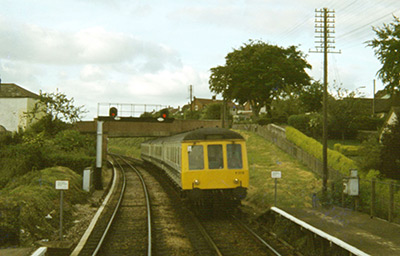Class 116 Derby 3-car Suburban DMUs
Operations
As delivered, the first 29 sets went to Tysley depot for use in the West Midlands, the remaining 13 sets of batch one and all of batch two went to Cardiff for use in South Wales, and all of batch three went to Bristol.
In time, transfers would see them allocated to all other regions apart from the Southern Region.
The final years saw the remaining vehicles all allocated to Tyseley depot with the final withdrawals from passenger use in 1995.
West Midlands
The first 29 3-car sets (87 vehicles) of batch one were delivered to 84E (Tyseley — a Western Region depot until January 1963 when it transfered to the London Midland Region). For many of these it would be their only allocation until withdrawal.
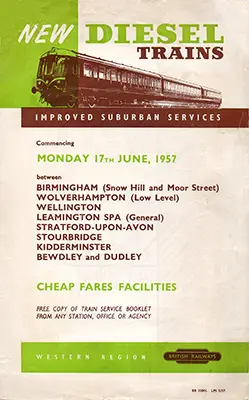
The class first entered traffic on the 17th June 1957 operating Western Region suburban services radiating from Birmingham Snow Hill. This was the same day as the Swindon 79xxx Inter-City sets were introduced on the region on services from Birmingham to Cardiff and Swansea.
After a fanfare of publicity, posters and pamphlets showing diesel trains, and having set 50058/59008/50100 on exhibition at Snow Hill on the 14th June, it was a bit of an anti-climax on the official introduction date of the 17th to find that less than half the trains were actually diesels (only around half of the 29 sets had so far been delivered). The public was disappointed and sceptical, and at least two DMU services failed that day. The steam hauled trains working to the DMU schedule had difficulty keeping time because of running around and water stops.
The "improved suburban services" by "new diesel trains" described in the single sheet handbill (which featured a route map on the rear) had suffered from various delays in the deliveries of the new sets, and it was expected to be mid-August before the Wellington, Kidderminster, Stratford-on-Avon and Leamington services could be fully implemented.
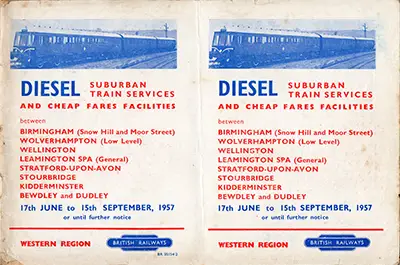
At the time the sets were stabled overnight at terminal points with Tyseley the service centre. A single road shed was being built at Leamington. Noted seen to this date were 50050 - 68 plus partners.
The Birmingham services included a regular interval service from Lapworth to Wellington with some extended to Shrewsbury and others to Leamington Spa (General). An hourly regular interval service ran to Stratford-upon-Avon via the North Warwickshire line and the 116s also worked between Leamington and Stratford-upon-Avon and Bewdley - Kidderminster - Birmingham. The Stourbridge Jct - Stourbridge Town service was to remain steam worked.
The remaining 13 sets of batch one — and all of batch two — would be delivered to Cardiff where they would begin to be introduced to services in South Wales from the 2nd December 1957.
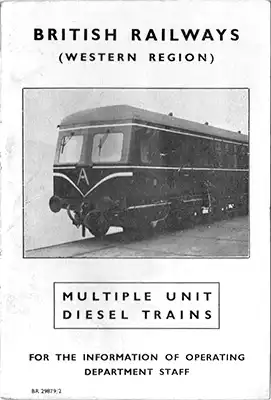
Staff booklet
The region produced a 6" x 4" booklet to give guidance to operating staff on their new diesel trains. As well as these suburban triples it also covered the Inter-Cities, Cross Countries and single cars. Download PDF (8mb). They produced a similar booklet for their Diesel Pullman trains.
1958
By the start of 1958 the West Midland 116s were part of Tyseley’s pool of 107 vehicles (33 3-cars and eight singles inc. Parcels cars) which operated all Birmingham local and suburban traffic, including some longer runs to Worcester, Oxford and Didcot. 87 of them were 116s and 12 120s. While all were based at Tyseley there were additional fuelling and servicing points at Leamington, Wolverhampton Cannock Road and Stourbridge[1]. They had shown satisfactory results, in the first four months of diesel operation passenger bookings rose by 360,000, 28% greater than the previous years, receipts rising by £32,000 or 22 1/2 %. Some of the increase was credited to a bus strike and increase in bus fares.
At the start of 1958 three spare Tyseley sets were split and the power cars added to 3-car sets to provide additional seating on certain services. Or that is one possibility, the other being the widely believed fact that they were underpowered and could not keep to timings. However it was reported in the enthusiast press that a 3-car set could easily maintain timings with one engine out of use. There was also a 5-car operating, with a power car and trailer added. One other problem that the sets had at this time was with the vacuum brake system.

A batch two set entering Worcester Foregate Street with the 9.55am Birmingham Snow Hill - Great Malvern service on March 9, 1958. Michael Mensing.
Shed code/set numbers, in the form of small oblong plates (white lettering on a green background), fixed on the frame of the end coach, started appearing around March 1958. An example was 50051/59001/50055 carrying TYS 305. Several of the later type sets were working in the Birmingham area during February / March. They had indicator blinds for the South Wales area. Those noted were in the series 50830-51/59338-59/50883-904.
The Birmingham to Oxford & Didcot service started Monday 21/4/58 after several weeks of driver training. A 6-car set worked the 16:40 from Wolverhampton to Didcot, where they are stabled overnight, returning the next morning at 07:04. A 3-car set formed the 08:40 Wolverhampton to Oxford and 11:20 return. In the summer timetable this had point-to-point timings of 25 mins for the 23 miles from Oxford to Banbury, and 22 mins for the 20 miles from Banbury to Leamington, both start to stop.
On the 10th June 1958 bubble 55009 was noted attached to a Class 116 power & centre car, and was working between Birmingham Snow Hill and Lapworth.
Noted at Swindon on the 27th July 1958 were 50050/70, and a 'new set for the London area' 51128/59438/51141. It would be delivered to Bristol Marsh Junction.
In September 1958 it was noted that it was difficult to find a set in the formation it left Derby. There were still 4-car sets made up of three power cars and one trailer used on rush hour services. Also noted were 2-car Class 122s working with them, such as 55009/56292/59360/50852). An argument against the lack of power idea!
Bristol
Deliveries of the third batch followed directly after the second, these thirteen sets (51128-40 + 59438-48 + 51141-53) were delivered to Bristol Marsh Junction between July and November 1958.
After seven weeks of driver training turns the first phase of the Bristol Suburban dieselisation scheme was introduced on the 6th October 1958. At this time there were just four DMU rosters, three for the Bristol local services and one for the Chippenham - Calne branch. 3-car sets were used, except for Suns to Fris on the Calne branch, when the centre car was removed to enable the two power cars to tow the sausage vans from C&T Harris's works at Calne. About half of the Bristol - Clifton Down - Avonmouth - Severn Beach - Pilning - Bristol, and Henbury line trips were now diesel worked, all by 3-car sets. One weekday diagram included a morning trip from Bristol to Chippenham and back. The Calne set ran light from Dr. Day's sidings, Bristol, early every morning, returning after the last branch trip at night. It was reported that phase two of the diesel programme would take place early in November, doubling the current workings by DMU. By Oct 6th there were eleven 3-car sets at Bristol in preparation for this.

The image shows 51147 + 59444 + 51134 in Bristol Temple Meads station on the 6th October 1958. It's working an Avonmouth service. Stuart Mackay Collection.
Phase two came into effect on Monday 17th November 1958. Three new 3-cars were involved, making a total of seven, plus the Calne branch set. All services on the Clifton Down line were now DMUs, although none had yet worked the Portishead branch, which was still steam and GWR railcar. Main line workings of the sets included the 10:30 Bristol - Westbury and 12:30 return, 18:30 Bristol - Chippenham and 22:18 (SO) return, 22:30 Bristol - Weston-super-Mare and 00:15 return (Sunday mornings only, other days light to Dr Day's).
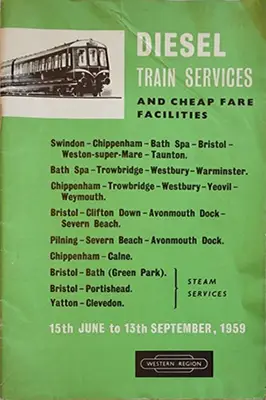
55009 was again (still?) noted working with two Class 116 vehicles, on the 25th February 1959 when it was on the 14:05 Birmingham Snow Hill to Stratford-upon-Avon.
51135/48 were noted working with 55018 on the 1st May 1959, and on the same day 50904 / 50851 were noted in Southall.
By October 1959 the other WR sets were acquiring set numbers. These were relevant to each depot, and changed if they were transferred. The 3XX and 4XX series was used for suburban sets, prefixed by the depot code, and were displayed on small rectangular plates fixed in clips to the solebars of the power cars only.
The depot codes were: CAT - Cardiff (Cathays); CDF - Cardiff (Canton); BL - Bristol; RDG - Reading, and TYS - Tyseley.
An examples was 51135/59443/59447/51148 which was Bristol’s BL307 (one of several 4-car sets, although the majority were 3-cars).
London
The first set that seems to have been allocated to the London area is W50054 + W59020 + W50111 which was transferred from Tyseley to Southall in February 1959. It moved back to Tyseley the following month.
A crisis arose on the WR London Operating District towards the end of 1959. The delivery of the Pressed Steel DMUs was delayed, and an attempt was made to work the new diesel timings in the Winter timetable with steam trains resulted in deplorable timekeeping. As a temporary measure DMUs were borrowed from Tyseley and Cardiff, resulting in some advertised diesel services in these areas returning to steam. All but two Cardiff sets were returned within a fortnight when about twenty Cathays suburban sets were sent to the London District. Cathays in turn borrowed 2 and 4-car Derby Lightweights from Gosforth, which because of their MU code were restricted in what they could do. They were noted on the Rhymney and Barry lines. Class 116 sets noted on loan working in the Paddington suburban area included:
50064 / 59008 / 50109 - TYS 324
50831 / 59339 / 50884 - no set no.
50838 / 59346 / 50891 - no set no.
50109 was noted carrying a 84E shed plate on the solebar.
Noted on outer suburban services between Paddington, Reading and Oxford during the week ending 19/12/59 were:
50833 / 59341 / 50886 - CAT 317
50827 / 59367 / 50880 - RDG 300
50841 / 59349 / 50894 - RDG 301
50079 / 59351 / 50121 - RDG 303
50837 / 59358 / 50890 - no set no.
51130 / 59440 / 51143 - BL
A problem with these sets is that they did not have ATC clip-up gear and so could not operate around Paddington Suburban, as the lines there were still electrified. DMUs without clip-up gear had thus to run in and out of the main-line station.
Bubble cars were still being noted working with 116s at the end of 1959.
The mid-1960s also saw the contraction of the Southern Region to the WR's benefit. To help cover some of the longer journeys some toilet sets were created by swapping vehicles with Class 120 sets.
Mark Alden notes that 51128 + 59357 + 51141 were at Exeter on 10/08/72. They had failed on Exeter bank working 2B95, the 15.35 Exeter - Exmouth Junction. They were then pushed to Exeter Central (terminated) and then hauled back to St. Davids by Peak D185. The set was then hauled by Warship 825 on 2B58 17.03 Exeter - Axminster and return 5B58 17.52 ECS via Chard Junction.
Inter Regional Transfers
Scottish Region
The first regional transfers took place in October 1966 when three sets moved, one each from from Cardiff, Bristol, and Plymouth to the Scottish Region at Hamilton (66C / HN). By the end of the year there were eight sets there, and sets would continue to operate in Scotland until 1987.

North Eastern Region
In November 1966 four sets (vehicles 50824/27/28/30, 50877/80/83/906, 59332/36/43/61) moved to the North Eastern Region at South Gosforth where they would be used on North Tyne electric routes and occasionally to Berwick. They moved 'on loan' but the moves were made permanent.
They also worked to Carlisle, the image shows E50830/59343/50883 on 2N73 the 1125 Carlisle to Newcastle departing from stop at Brampton Fell signalbox on 1st March 1968. Keith Long.

Eastern Region
In June 1968 one of the South Gosforth sets (50830 + 59343 + 50883) moved to Finsbury Park, the other three sets followed in July 1968.
The image shows E50906 at the front of two Class 116 sets in Kings Cross in the late 1960s. Steve Davies Collection.
After a decade at Finsbury Park, the four sets moved to Tyseley in February 1978.

London Midland Region
In July 1968 50054/60/8/71, 50101/6/11 and 59008/17/21 moved from Tyseley to Cricklewood. They replaced the Rolls-Royce Cravens sets on City Widened Lines services as the restriction on longer vehicles had been lifted. In September they were joined by 50840 + 59348 + 50893 from 86A, and 50838/49/50/70 and 50891/902/3/23 from 84A (and centre cars?), and in October 1969 another two Tyseley sets arrived - 50063/75, 50102/14 and 59011/20. In February 1970 50073/100 also moved from Tyseley, and other sets arrived later in the 1970s. The image shows a Class 116 set entering Farringdon in 1973. John Law.
Sets would also be noted running on services to Luton around 1973/4, either with an extra power car added to match the power / capacity of the normal sets on the route — the Class 127s, or as three power cars. This image shows a set with an extra power car attached on a Barking service in 1979.
In 1970 seven sets moved from the WR to Stratford (SF) in east London for use on services from Liverpool St. Station. All these units were the expendable non-gangwayed cars made redundant on the WR by line closure and the introduction of "pay train" operation. At this time the fitting of gangways to all the remaining WR sets was well under way, this resulted in further mixing of power cars and trailer vehicles as gangway fitted trailers were not always returned to their correct operating sets and most of the vehicles built as 2-car units aquired gangwayed trailers which had originally operated in other sets. Three digit set numbers started to appear on the cab fronts at about this time, and by 1971 the prefix ‘C’ for Cardiff and ‘P’ for Plymouth had appeared. Units based in the London area received L prefixes a year or two earlier. Previously set numbers had been carried on the solebar of all WR units, prefixed by either CAT for Cardiff Cathays, BTL for Bristol Marsh Junction, and LA for Plymouth Laira. The Tyseley based units carried three digit black on white unit numbers on a plate displayed at the bottom of the second man’s cab window, this later being superceeded by a white on black plate bearing the depot code ‘TYS’ and later ‘TS’ the set number which was also the diagram number, and the day’s date which was written in chalk.
By 1974 a further five 3-car sets had been dispatched to Scotland, this time including some gangwayed units reflecting the contracting services for the class in the South Wales valleys, and the West of England. Transfers continued to take place throughout the 1970s and 1980s particularly between the SCR and ER with Scottish allocated sets moving to Stratford (SF) and some the other way. 1976 saw a major set renumbering of the WR units, and the transfer of five Class 117 3-car sets from the London division to Cardiff, their TC(L) trailers were stored and five gangway fitted Class 116 TS cars were substituted, these trailers being removed from Laira based units which received trailers of Class 118 and 101. The Class 117s were later refurbished while still at (CF) along with their 116 trailers and when eventually transferred to Bristol (BR) their original trailers were returned, the 116 trailers took their places back in Class 116 sets at Cardiff.
P319 is seen arriving at Honiton, led by 50868, with the evening Axminster to Exeter St. Davids. 13th July 1979. Neil Cannon.
Misc
Both Tyseley and Cardiff units could be seen operating in very long trains, nine car formations were not uncommon these looking very impressive indeed if not a little unwieldy when negotiating complex point work or winding their serpentine way up a Welsh mining valley. Three car units could often be seen hauling a BG or a GUV in their earlier days as a 3-car set was allowed a 100ton trailing load. It was common practice for single units and/or their DTS cars to be attached and detached at various interchange stations on route which would then go on independently to serve other connecting routes, perhaps rejoining a service later in the day or at peak times. A good example of this practice was the Cardiff - Treherbert service, prior to 1969 certain journeys would be lead by a Class 121 ‘Bubble Car’ which on arrival at Treherbert would be detached the 3-car 116 would then form the Treherbert - Barry Island service, while the single unit would continue on, forming the Treherbert - Bridgend service via the single track Blaenrhondda tunnel and Cymmer Afan. Sadly this through service ceased in 1969 due allegedly to the cost of repairing the mile long tunnel.
This 1976 video made for schools includes a trip on a Class 116 from Kidderminster to Birmingham. While the editing is mixed up with lineside glimpses in the wrong order there are lots of interior shots of the inside of the train and drivers controls.
It was common practise for Class 116 vehicles to run with other types, as already mentioned, normally involving Classes 121, 122 and their respective DTS cars, this was also the case at Laira and at Tyseley, while the Scottish and Eastern units being paired with many more varieties, it being not uncommon to observe a Craven Class 105 2-car set working with a 3-car 116, on the ER.
References
- ⋏ "Western Region Diesel Services", p420 11 April 1958 Railway Gazette
Summary
Description
Modifications
Works Photographs
Diagrams
Numbering
Drivers Instructions
Liveries
Operations
- South Wales
- Scotland
Accidents
Railair Express Parcels set
Parcel Use
Refurbishment
Hybrids
Decline
Departmental Use
Images
Details about preserved Class 116s can be found here.
Thanks to Mac Winfield, Ian Fleming and John Thomlinson for much of the information on this Class.




